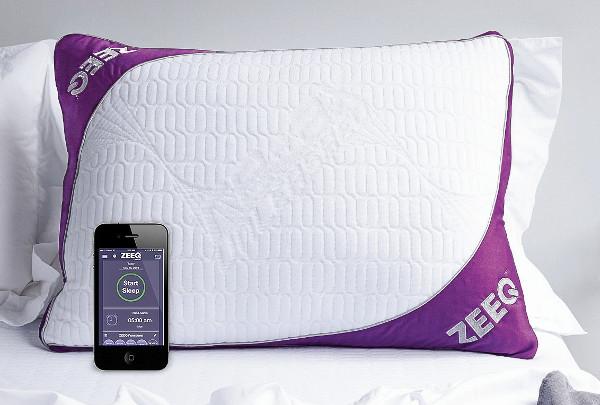Sleeping with Apps

Given S&V’s penchant for speakers, I decided to lay down with the ZEEQ Smart Pillow by REM-Fit. The pillow (26.5 x 16.75 x 5.5 inches) embeds eight wireless speakers (four on each side), a microphone, two vibration motors, a three-axis gyroscope, a rechargeable lithium-ion battery (affording about two weeks of usage), and a wired remote. The 7-pound pillow is a bit hefty, but the electronics are buried under an outer foam shell that makes pressing your head against it surprisingly snug. A white pillowcase and extra fill are included.
You download the ZEEQ app (for Android phones or iPhones but not iPads) and create your sleep profile. (Call me Sandman.) I set my wake-up time to 6 a.m. weekdays; 7 a.m. weekends. You adjust the sensitivity of the microphone for monitoring your snoring, the intensity of the vibrations for waking you to rise or stop snoring, and the default speaker volume. Programming the pillow is complicated, so you shouldn’t do it just before going to bed.
When I hit the sack, a crickets-and-owls-infused medley percolated from the pillow for 15 minutes. You choose the duration and the effects. I could have selected Resting Shores, but I went with Calming Sounds of the Night Forest so I wouldn’t stress over a tsunami.
If you’re uninspired by sound effects, you can select downloaded music, a podcast, or an audio book. For streaming from the cloud, you’ll need a Spotify Premium account. The speakers, even when turned up, can barely be heard away from the pillow. This may be the first speaker array purposefully built to be muffled. If you share the bed with someone who craves quiet but you don’t want to wear any device that comes between you and your pillow, ZEEQ is a good thing.
Though the app likened the decibel level of my snoring to a power drill, I never felt the pillow vibrate when it detected snoring. Honestly, I can’t be sure because I was sleeping. But when I feigned snoring, the pillow just lay there, not a single vibration nudging me to cease and desist. As a means to stop snoring, ZEEQ didn’t do it for me. There’s no option to wake up to music or news. At your prescribed time, ZEEQ simply vibrates. If you fail to touch the app’s wake-up button, the pillow will vibrate at 5-minute intervals for the next 25 minutes. Don’t give up your clock radio or a dedicated wake-up app.
Upon rising one morning, I achieved a sleep score of 91, a personal best — not that I had any inclination to share my good night’s sleep on social media, something the company encourages you to do. Maybe they see a self-promoting user base in which vying for the title of champion sleeper is Facebook-worthy, but competitive napping isn’t for me.
The pillow has the disconcerting habit of powering itself on, the LED on the wired remote moonlighting as a nightlight. Once the battery drained, I moved the ZEEQ to the top of my closet. You never know when an extra pillow can come in handy.
The ZEEQ Smart Pillow is currently available at the discounted price of $200 (regular price is $300) at rem-fit.com.














































